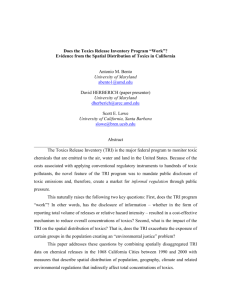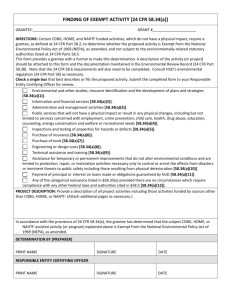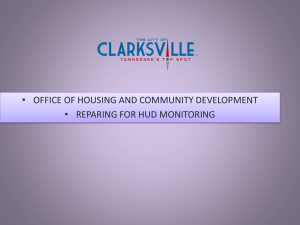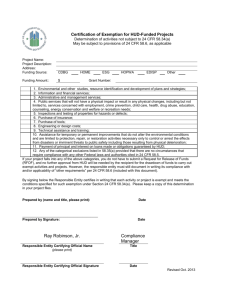Air Toxics
advertisement
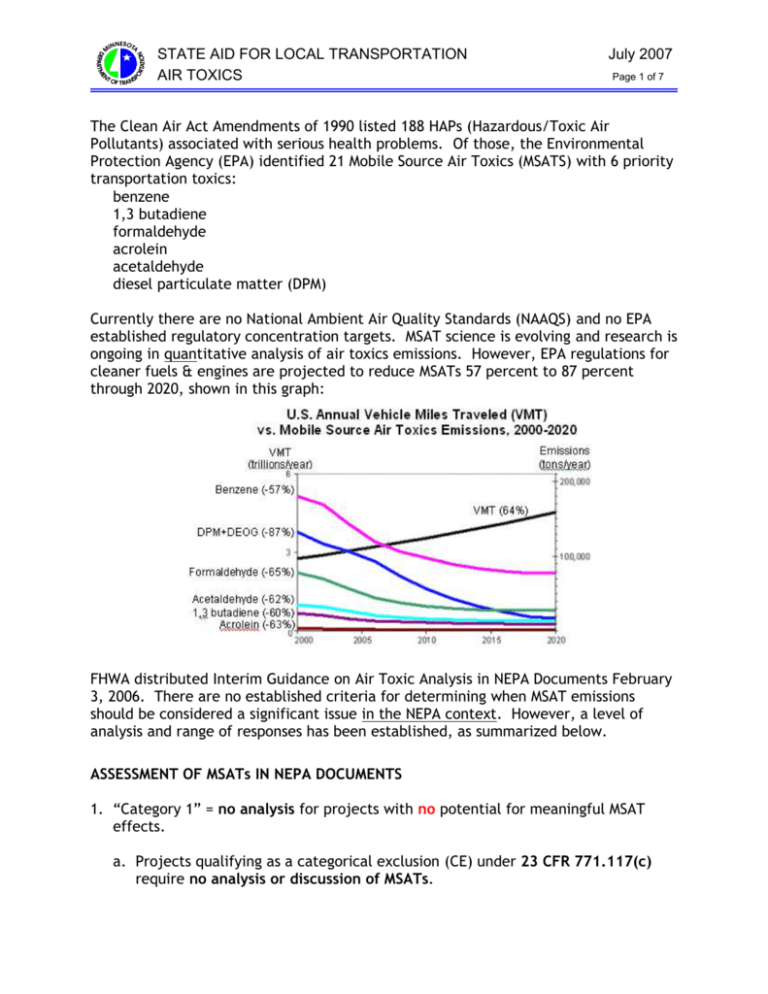
STATE AID FOR LOCAL TRANSPORTATION AIR TOXICS July 2007 Page 1 of 7 The Clean Air Act Amendments of 1990 listed 188 HAPs (Hazardous/Toxic Air Pollutants) associated with serious health problems. Of those, the Environmental Protection Agency (EPA) identified 21 Mobile Source Air Toxics (MSATS) with 6 priority transportation toxics: benzene 1,3 butadiene formaldehyde acrolein acetaldehyde diesel particulate matter (DPM) Currently there are no National Ambient Air Quality Standards (NAAQS) and no EPA established regulatory concentration targets. MSAT science is evolving and research is ongoing in quantitative analysis of air toxics emissions. However, EPA regulations for cleaner fuels & engines are projected to reduce MSATs 57 percent to 87 percent through 2020, shown in this graph: FHWA distributed Interim Guidance on Air Toxic Analysis in NEPA Documents February 3, 2006. There are no established criteria for determining when MSAT emissions should be considered a significant issue in the NEPA context. However, a level of analysis and range of responses has been established, as summarized below. ASSESSMENT OF MSATs IN NEPA DOCUMENTS 1. “Category 1” = no analysis for projects with no potential for meaningful MSAT effects. a. Projects qualifying as a categorical exclusion (CE) under 23 CFR 771.117(c) require no analysis or discussion of MSATs. STATE AID FOR LOCAL TRANSPORTATION AIR TOXICS July 2007 Page 2 of 7 b. Projects exempt under the Clean Air Act conformity rule under 40 CFR 93.126 require no analysis or discussion of MSATs. c. Other projects with “no meaningful impacts” on traffic volumes or vehicle mix require consideration of impacts. i. Document basis for the determination of "no meaningful potential impacts" with a brief description of the factors considered. ii. While CE projects under 23 CFR 771.117(d) or those exempt from conformity under 40 CFR 93.127 do not warrant an automatic exemption from an MSAT analysis, they usually have no meaningful impact. iii. Use AIR TOXICS CATEGORY 1 SAMPLE WRITEUP on State Aid for Local Transportation website. 2. “Category 2” = qualitative analysis for projects with low potential MSAT effects. a. Improvements without substantial new capacity, where future ADT<150,000. b. Projects creating new lanes or relocating lanes (or economic activity) closer to homes, schools, businesses and other sensitive receptors. c. Compare the expected effect of the project on traffic volumes, vehicle mix, or routing of traffic and the associated changes in MSATs for the project alternatives. d. Discuss anticipated reductions in emissions due to stricter engine and fuel regulations. e. Write-up for four examples of projects: i. Widening projects with future AADT <150,000 (minor). Use AIR TOXICS CATEGORY 2 SAMPLE WRITEUP--Widening on State Aid for Local Transportation website. ii. New interchange with new connector roadway ie: new roadway segment connects to an existing limited access highway to meet regional travel needs by providing a more direct route between locations. Use AIR TOXICS CATEGORY 2 SAMPLE WRITEUP--New Interchange With New Connector Roadway on State Aid for Local Transportation website. iii. New interchange NO new connector roadway ie: roadway purpose in response to or in anticipation of economic development. ie: a new interchange replacing a signalized intersection to serve a new shopping/residential development. Use AIR TOXICS CATEGORY 2 SAMPLE WRITEUP--New Interchange NO New Connector Roadway on State Aid for Local Transportation website. STATE AID FOR LOCAL TRANSPORTATION AIR TOXICS July 2007 Page 3 of 7 iv. Expanded intermodal centers or other projects which impact truck traffic short of Category 3 below. ie: change in truck or rail activity resulting in change in MSAT emissions patterns. Use AIR TOXICS CATEGORY 2 SAMPLE WRITEUP—Expanded Intermodal Center/Truck Impacts on State Aid for Local Transportation website. 3. “Category 3” = quantitative analysis for projects with higher potential MSAT effects. a. Adding new or significant capacity to interstates, urban arterials, or urban collector-distributor routes, where future ADT > 140,000 to 150,000. i. Widening projects with future ADT>140,000 to 150,000 (major). ii. New or expanded major intermodal freight facility. iii. AND, are in proximity to populated areas or concentrations of vulnerable populations in rural areas (i.e., schools, nursing homes, hospitals). b. Projects with potential to concentrate high levels of diesel particulate matter in a single location. c. Projects with potential to have meaningful differences among project alternatives. d. Develop quantitative assessment approach and cumulative impact considerations with FHWA. e. Consider mitigation and construction strategies. Based on “FHWA Interim Guidance on Air Toxic Analysis in NEPA Documents” dated 2/3/06, http://www.fhwa.dot.gov/environment/airtoxic/020306guidmem.htm STATE AID FOR LOCAL TRANSPORTATION AIR TOXICS July 2007 Page 4 of 7 23 CFR 771.117(c): (1) Activities which do not involve or lead directly to construction, such as planning and technical studies; grants for training and research programs; research activities as defined in 23 U.S.C. 307; approval of a unified work program and any findings required in the planning process pursuant to 23 U.S.C. 134; approval of statewide programs under 23 CFR part 630; approval of project concepts under 23 CFR part 476; engineering to define the elements of a proposed action or alternatives so that social, economic, and environmental effects can be assessed; and Federal-aid system revisions which establish classes of highways on the Federal-aid highway system. (2) Approval of utility installations along or across a transportation facility. (3) Construction of bicycle and pedestrian lanes, paths, and facilities. (4) Activities included in the State's highway safety plan under 23 U.S.C. 402. (5) Transfer of Federal lands pursuant to 23 U.S.C. 317 when the subsequent action is not an FHWA action. (6) The installation of noise barriers or alterations to existing publicly owned buildings to provide for noise reduction. (7) Landscaping. (8) Installation of fencing, signs, pavement markings, small passenger shelters, traffic signals, and railroad warning devices where no substantial land acquisition or traffic disruption will occur. (9) Emergency repairs under 23 U.S.C. 125. (10) Acquisition of scenic easements. (11) Determination of payback under 23 CFR part 480 for property previously acquired with Federal-aid participation. (12) Improvements to existing rest areas and truck weigh stations. (13) Ridesharing activities. (14) Bus and rail car rehabilitation. (15) Alterations to facilities or vehicles in order to make them accessible for elderly and handicapped persons. (16) Program administration, technical assistance activities, and operating assistance to transit authorities to continue existing service or increase service to meet routine changes in demand. (17) The purchase of vehicles by the applicant where the use of these vehicles can be accommodated by existing facilities or by new facilities which themselves are within a CE. (18) Track and railbed maintenance and improvements when carried out within the existing right-of-way. (19) Purchase and installation of operating or maintenance equipment to be located within the transit facility and with no significant impacts off the site. (20) Promulgation of rules, regulations, and directives. --------------------40 CFR 93.126 Table 2--Exempt Projects Safety Railroad/highway crossing. STATE AID FOR LOCAL TRANSPORTATION AIR TOXICS July 2007 Page 5 of 7 Hazard elimination program. Safer non-Federal-aid system roads. Shoulder improvements. Increasing sight distance. Safety improvement program. Traffic control devices and operating assistance other than signalization projects. Railroad/highway crossing warning devices. Guardrails, median barriers, crash cushions. Pavement resurfacing and/or rehabilitation. Pavement marking demonstration. Emergency relief (23 U.S.C. 125). Fencing. Skid treatments. Safety roadside rest areas. Adding medians. Truck climbing lanes outside the urbanized area. Lighting improvements. Widening narrow pavements or reconstructing bridges (no additional travel lanes). Emergency truck pullovers. Mass Transit Operating assistance to transit agencies. Purchase of support vehicles. Rehabilitation of transit vehicles Purchase of office, shop, and operating equipment for existing facilities. Purchase of operating equipment for vehicles (e.g., radios, fareboxes, lifts, etc.). Construction or renovation of power, signal, and communications systems. Construction of small passenger shelters and information kiosks. Reconstruction or renovation of transit buildings and structures (e.g., rail or bus buildings, storage and maintenance facilities, stations, terminals, and ancillary structures). Rehabilitation or reconstruction of track structures, track, and track bed in existing rights-of-way. Purchase of new buses and rail cars to replace existing vehicles or for minor expansions of the fleet. Construction of new bus or rail storage/maintenance facilities categorically excluded in 23 CFR part 771. Air Quality Continuation of ride-sharing and van-pooling promotion activities at current levels. Bicycle and pedestrian facilities. Other Specific activities which do not involve or lead directly to construction, such as: Planning and technical studies. Grants for training and research programs. Planning activities conducted pursuant to titles 23 and 49 U.S.C. Federal-aid systems revisions. STATE AID FOR LOCAL TRANSPORTATION AIR TOXICS July 2007 Page 6 of 7 Engineering to assess social, economic, and environmental effects of the proposed action or alternatives to that action. Noise attenuation. Emergency or hardship advance land acquisitions (23 CFR 710.503). Acquisition of scenic easements. Plantings, landscaping, etc. Sign removal. Directional and informational signs. Transportation enhancement activities (except rehabilitation and operation of historic transportation buildings, structures, or facilities). Repair of damage caused by natural disasters, civil unrest, or terrorist acts, except projects involving substantial functional, locational or capacity changes. --------------------------23 CFR 771.117 (d): (1) Modernization of a highway by resurfacing, restoration, rehabilitation, reconstruction, adding shoulders, or adding auxiliary lanes (e.g., parking, weaving, turning, climbing). (2) Highway safety or traffic operations improvement projects including the installation of ramp metering control devices and lighting. (3) Bridge rehabilitation, reconstruction or replacement or the construction of grade separation to replace existing at-grade railroad crossings. (4) Transportation corridor fringe parking facilities. (5) Construction of new truck weigh stations or rest areas. (6) Approvals for disposal of excess right-of-way or for joint or limited use of right-ofway, where the proposed use does not have significant adverse impacts. (7) Approvals for changes in access control. (8) Construction of new bus storage and maintenance facilities in areas used predominantly for industrial or transportation purposes where such construction is not inconsistent with existing zoning and located on or near a street with adequate capacity to handle anticipated bus and support vehicle traffic. (9) Rehabilitation or reconstruction of existing rail and bus buildings and ancillary facilities where only minor amounts of additional land are required and there is not a substantial increase in the number of users. (10) Construction of bus transfer facilities (an open area consisting of passenger shelters, boarding areas, kiosks and related street improvements) when located in a commercial area or other high activity center in which there is adequate street capacity for projected bus traffic. (11) Construction of rail storage and maintenance facilities in areas used predominantly for industrial or transportation purposes where such construction is not inconsistent with existing zoning and where there is no significant noise impact on the surrounding community. (12) Acquisition of land for hardship or protective purposes; advance land acquisition loans under section 3(b) of the UMT Act. Hardship and protective buying will be permitted only for a particular parcel or a limited number of parcels. These types of land acquisition quality for a CE only where the acquisition will not limit the evaluation of alternatives, including shifts in alignment for planned construction STATE AID FOR LOCAL TRANSPORTATION AIR TOXICS July 2007 Page 7 of 7 projects, which may be required in the NEPA process. No project development on such land may proceed until the NEPA process has been completed. --------------------40 CFR 93.127 Table 3--Projects Exempt From Regional Emissions Analyses Intersection channelization projects. Intersection signalization projects at individual intersections. Interchange reconfiguration projects. Changes in vertical and horizontal alignment. Truck size and weight inspection stations. Bus terminals and transfer points.


